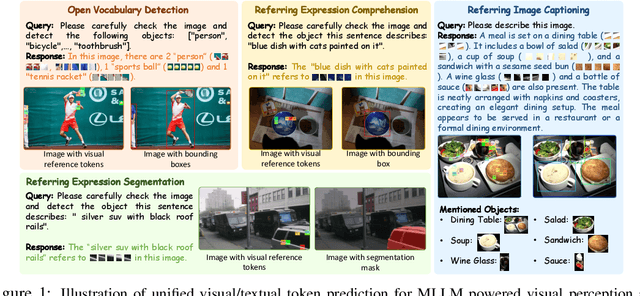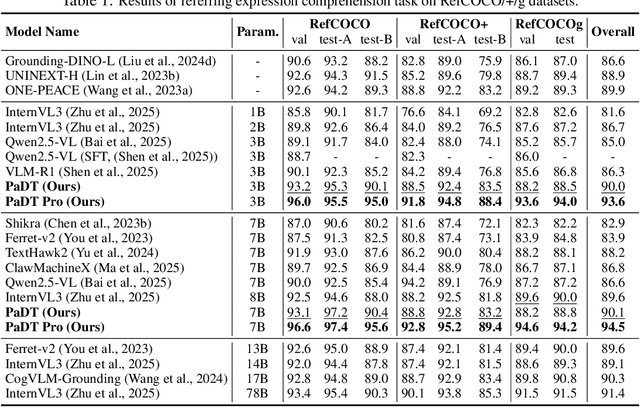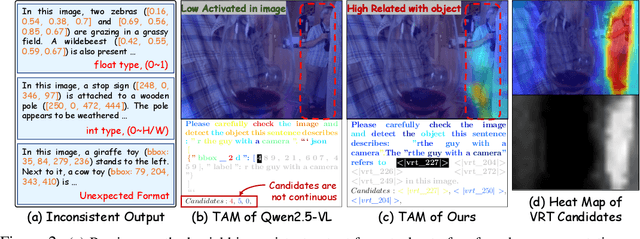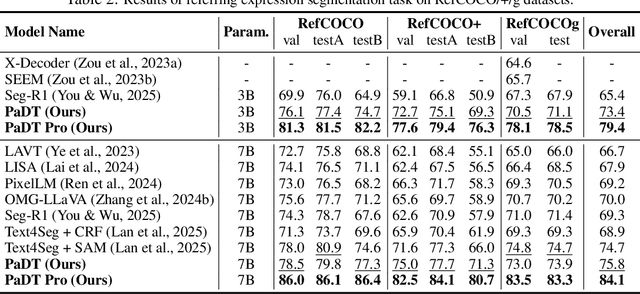Object Detection
Object detection is a computer vision task in which the goal is to detect and locate objects of interest in an image or video. The task involves identifying the position and boundaries of objects in an image, and classifying the objects into different categories. It forms a crucial part of vision recognition, alongside image classification and retrieval.
Papers and Code
Patch-as-Decodable-Token: Towards Unified Multi-Modal Vision Tasks in MLLMs
Oct 02, 2025



Multimodal large language models (MLLMs) have advanced rapidly in recent years. However, existing approaches for vision tasks often rely on indirect representations, such as generating coordinates as text for detection, which limits performance and prevents dense prediction tasks like segmentation. To overcome these challenges, we introduce Patch-as-Decodable Token (PaDT), a unified paradigm that enables MLLMs to directly generate both textual and diverse visual outputs. Central to PaDT are Visual Reference Tokens (VRTs), derived from visual patch embeddings of query images and interleaved seamlessly with LLM's output textual tokens. A lightweight decoder then transforms LLM's outputs into detection, segmentation, and grounding predictions. Unlike prior methods, PaDT processes VRTs independently at each forward pass and dynamically expands the embedding table, thus improving localization and differentiation among similar objects. We further tailor a training strategy for PaDT by randomly selecting VRTs for supervised fine-tuning and introducing a robust per-token cross-entropy loss. Our empirical studies across four visual perception and understanding tasks suggest PaDT consistently achieving state-of-the-art performance, even compared with significantly larger MLLM models. The code is available at https://github.com/Gorilla-Lab-SCUT/PaDT.
Personalization on a Budget: Minimally-Labeled Continual Learning for Resource-Efficient Seizure Detection
Sep 17, 2025Objective: Epilepsy, a prevalent neurological disease, demands careful diagnosis and continuous care. Seizure detection remains challenging, as current clinical practice relies on expert analysis of electroencephalography, which is a time-consuming process and requires specialized knowledge. Addressing this challenge, this paper explores automated epileptic seizure detection using deep learning, focusing on personalized continual learning models that adapt to each patient's unique electroencephalography signal features, which evolve over time. Methods: In this context, our approach addresses the challenge of integrating new data into existing models without catastrophic forgetting, a common issue in static deep learning models. We propose EpiSMART, a continual learning framework for seizure detection that uses a size-constrained replay buffer and an informed sample selection strategy to incrementally adapt to patient-specific electroencephalography signals. By selectively retaining high-entropy and seizure-predicted samples, our method preserves critical past information while maintaining high performance with minimal memory and computational requirements. Results: Validation on the CHB-MIT dataset, shows that EpiSMART achieves a 21% improvement in the F1 score over a trained baseline without updates in all other patients. On average, EpiSMART requires only 6.46 minutes of labeled data and 6.28 updates per day, making it suitable for real-time deployment in wearable systems. Conclusion:EpiSMART enables robust and personalized seizure detection under realistic and resource-constrained conditions by effectively integrating new data into existing models without degrading past knowledge. Significance: This framework advances automated seizure detection by providing a continual learning approach that supports patient-specific adaptation and practical deployment in wearable healthcare systems.
Model-Agnostic Open-Set Air-to-Air Visual Object Detection for Reliable UAV Perception
Sep 11, 2025Open-set detection is crucial for robust UAV autonomy in air-to-air object detection under real-world conditions. Traditional closed-set detectors degrade significantly under domain shifts and flight data corruption, posing risks to safety-critical applications. We propose a novel, model-agnostic open-set detection framework designed specifically for embedding-based detectors. The method explicitly handles unknown object rejection while maintaining robustness against corrupted flight data. It estimates semantic uncertainty via entropy modeling in the embedding space and incorporates spectral normalization and temperature scaling to enhance open-set discrimination. We validate our approach on the challenging AOT aerial benchmark and through extensive real-world flight tests. Comprehensive ablation studies demonstrate consistent improvements over baseline methods, achieving up to a 10\% relative AUROC gain compared to standard YOLO-based detectors. Additionally, we show that background rejection further strengthens robustness without compromising detection accuracy, making our solution particularly well-suited for reliable UAV perception in dynamic air-to-air environments.
Cumulative Consensus Score: Label-Free and Model-Agnostic Evaluation of Object Detectors in Deployment
Sep 16, 2025Evaluating object detection models in deployment is challenging because ground-truth annotations are rarely available. We introduce the Cumulative Consensus Score (CCS), a label-free metric that enables continuous monitoring and comparison of detectors in real-world settings. CCS applies test-time data augmentation to each image, collects predicted bounding boxes across augmented views, and computes overlaps using Intersection over Union. Maximum overlaps are normalized and averaged across augmentation pairs, yielding a measure of spatial consistency that serves as a proxy for reliability without annotations. In controlled experiments on Open Images and KITTI, CCS achieved over 90% congruence with F1-score, Probabilistic Detection Quality, and Optimal Correction Cost. The method is model-agnostic, working across single-stage and two-stage detectors, and operates at the case level to highlight under-performing scenarios. Altogether, CCS provides a robust foundation for DevOps-style monitoring of object detectors.
IRDFusion: Iterative Relation-Map Difference guided Feature Fusion for Multispectral Object Detection
Sep 11, 2025Current multispectral object detection methods often retain extraneous background or noise during feature fusion, limiting perceptual performance.To address this, we propose an innovative feature fusion framework based on cross-modal feature contrastive and screening strategy, diverging from conventional approaches. The proposed method adaptively enhances salient structures by fusing object-aware complementary cross-modal features while suppressing shared background interference.Our solution centers on two novel, specially designed modules: the Mutual Feature Refinement Module (MFRM) and the Differential Feature Feedback Module (DFFM). The MFRM enhances intra- and inter-modal feature representations by modeling their relationships, thereby improving cross-modal alignment and discriminative power.Inspired by feedback differential amplifiers, the DFFM dynamically computes inter-modal differential features as guidance signals and feeds them back to the MFRM, enabling adaptive fusion of complementary information while suppressing common-mode noise across modalities. To enable robust feature learning, the MFRM and DFFM are integrated into a unified framework, which is formally formulated as an Iterative Relation-Map Differential Guided Feature Fusion mechanism, termed IRDFusion. IRDFusion enables high-quality cross-modal fusion by progressively amplifying salient relational signals through iterative feedback, while suppressing feature noise, leading to significant performance gains.In extensive experiments on FLIR, LLVIP and M$^3$FD datasets, IRDFusion achieves state-of-the-art performance and consistently outperforms existing methods across diverse challenging scenarios, demonstrating its robustness and effectiveness. Code will be available at https://github.com/61s61min/IRDFusion.git.
Analytic Conditions for Differentiable Collision Detection in Trajectory Optimization
Sep 30, 2025Optimization-based methods are widely used for computing fast, diverse solutions for complex tasks such as collision-free movement or planning in the presence of contacts. However, most of these methods require enforcing non-penetration constraints between objects, resulting in a non-trivial and computationally expensive problem. This makes the use of optimization-based methods for planning and control challenging. In this paper, we present a method to efficiently enforce non-penetration of sets while performing optimization over their configuration, which is directly applicable to problems like collision-aware trajectory optimization. We introduce novel differentiable conditions with analytic expressions to achieve this. To enforce non-collision between non-smooth bodies using these conditions, we introduce a method to approximate polytopes as smooth semi-algebraic sets. We present several numerical experiments to demonstrate the performance of the proposed method and compare the performance with other baseline methods recently proposed in the literature.
MVAT: Multi-View Aware Teacher for Weakly Supervised 3D Object Detection
Sep 09, 2025Annotating 3D data remains a costly bottleneck for 3D object detection, motivating the development of weakly supervised annotation methods that rely on more accessible 2D box annotations. However, relying solely on 2D boxes introduces projection ambiguities since a single 2D box can correspond to multiple valid 3D poses. Furthermore, partial object visibility under a single viewpoint setting makes accurate 3D box estimation difficult. We propose MVAT, a novel framework that leverages temporal multi-view present in sequential data to address these challenges. Our approach aggregates object-centric point clouds across time to build 3D object representations as dense and complete as possible. A Teacher-Student distillation paradigm is employed: The Teacher network learns from single viewpoints but targets are derived from temporally aggregated static objects. Then the Teacher generates high quality pseudo-labels that the Student learns to predict from a single viewpoint for both static and moving objects. The whole framework incorporates a multi-view 2D projection loss to enforce consistency between predicted 3D boxes and all available 2D annotations. Experiments on the nuScenes and Waymo Open datasets demonstrate that MVAT achieves state-of-the-art performance for weakly supervised 3D object detection, significantly narrowing the gap with fully supervised methods without requiring any 3D box annotations. % \footnote{Code available upon acceptance} Our code is available in our public repository (\href{https://github.com/CEA-LIST/MVAT}{code}).
Dual-Thresholding Heatmaps to Cluster Proposals for Weakly Supervised Object Detection
Sep 10, 2025Weakly supervised object detection (WSOD) has attracted significant attention in recent years, as it does not require box-level annotations. State-of-the-art methods generally adopt a multi-module network, which employs WSDDN as the multiple instance detection network module and multiple instance refinement modules to refine performance. However, these approaches suffer from three key limitations. First, existing methods tend to generate pseudo GT boxes that either focus only on discriminative parts, failing to capture the whole object, or cover the entire object but fail to distinguish between adjacent intra-class instances. Second, the foundational WSDDN architecture lacks a crucial background class representation for each proposal and exhibits a large semantic gap between its branches. Third, prior methods discard ignored proposals during optimization, leading to slow convergence. To address these challenges, we first design a heatmap-guided proposal selector (HGPS) algorithm, which utilizes dual thresholds on heatmaps to pre-select proposals, enabling pseudo GT boxes to both capture the full object extent and distinguish between adjacent intra-class instances. We then present a weakly supervised basic detection network (WSBDN), which augments each proposal with a background class representation and uses heatmaps for pre-supervision to bridge the semantic gap between matrices. At last, we introduce a negative certainty supervision loss on ignored proposals to accelerate convergence. Extensive experiments on the challenging PASCAL VOC 2007 and 2012 datasets demonstrate the effectiveness of our framework. We achieve mAP/mCorLoc scores of 58.5%/81.8% on VOC 2007 and 55.6%/80.5% on VOC 2012, performing favorably against the state-of-the-art WSOD methods. Our code is publicly available at https://github.com/gyl2565309278/DTH-CP.
MSGFusion: Multimodal Scene Graph-Guided Infrared and Visible Image Fusion
Sep 16, 2025Infrared and visible image fusion has garnered considerable attention owing to the strong complementarity of these two modalities in complex, harsh environments. While deep learning-based fusion methods have made remarkable advances in feature extraction, alignment, fusion, and reconstruction, they still depend largely on low-level visual cues, such as texture and contrast, and struggle to capture the high-level semantic information embedded in images. Recent attempts to incorporate text as a source of semantic guidance have relied on unstructured descriptions that neither explicitly model entities, attributes, and relationships nor provide spatial localization, thereby limiting fine-grained fusion performance. To overcome these challenges, we introduce MSGFusion, a multimodal scene graph-guided fusion framework for infrared and visible imagery. By deeply coupling structured scene graphs derived from text and vision, MSGFusion explicitly represents entities, attributes, and spatial relations, and then synchronously refines high-level semantics and low-level details through successive modules for scene graph representation, hierarchical aggregation, and graph-driven fusion. Extensive experiments on multiple public benchmarks show that MSGFusion significantly outperforms state-of-the-art approaches, particularly in detail preservation and structural clarity, and delivers superior semantic consistency and generalizability in downstream tasks such as low-light object detection, semantic segmentation, and medical image fusion.
A Synthetic Data Pipeline for Supporting Manufacturing SMEs in Visual Assembly Control
Sep 16, 2025Quality control of assembly processes is essential in manufacturing to ensure not only the quality of individual components but also their proper integration into the final product. To assist in this matter, automated assembly control using computer vision methods has been widely implemented. However, the costs associated with image acquisition, annotation, and training of computer vision algorithms pose challenges for integration, especially for small- and medium-sized enterprises (SMEs), which often lack the resources for extensive training, data collection, and manual image annotation. Synthetic data offers the potential to reduce manual data collection and labeling. Nevertheless, its practical application in the context of assembly quality remains limited. In this work, we present a novel approach for easily integrable and data-efficient visual assembly control. Our approach leverages simulated scene generation based on computer-aided design (CAD) data and object detection algorithms. The results demonstrate a time-saving pipeline for generating image data in manufacturing environments, achieving a mean Average Precision (mAP@0.5:0.95) up to 99,5% for correctly identifying instances of synthetic planetary gear system components within our simulated training data, and up to 93% when transferred to real-world camera-captured testing data. This research highlights the effectiveness of synthetic data generation within an adaptable pipeline and underscores its potential to support SMEs in implementing resource-efficient visual assembly control solutions.
 Add to Chrome
Add to Chrome Add to Firefox
Add to Firefox Add to Edge
Add to Edge